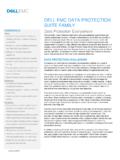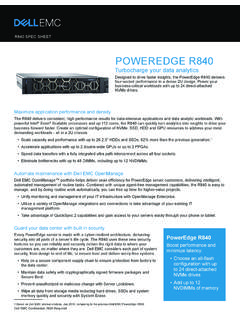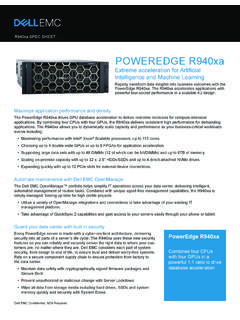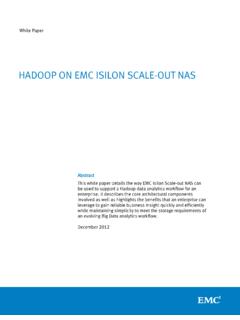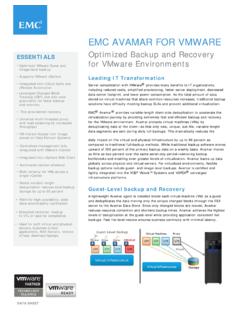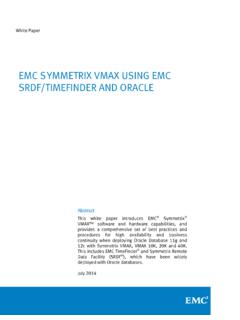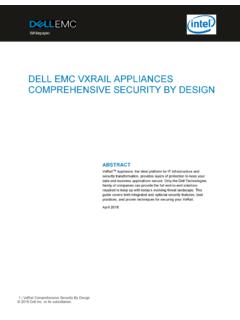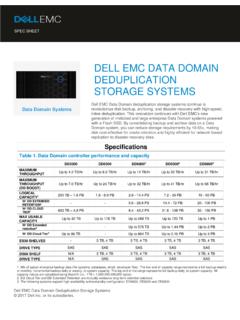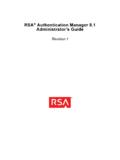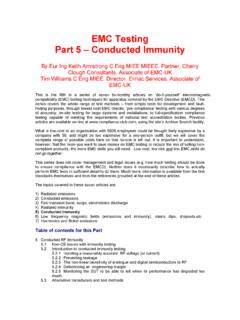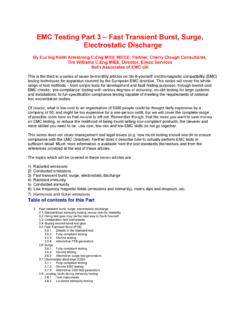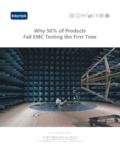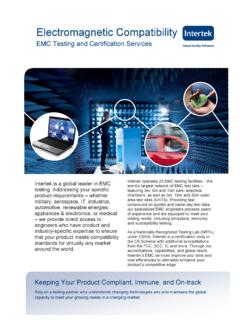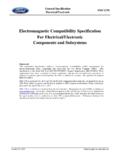Transcription of Exchange 2010 Disaster Recovery Options with Cross-site ...
1 White Paper EMC GLOBAL SOLUTIONS Abstract This white paper provides analysis, data points and design considerations on how a Microsoft Exchange Server 2010 Disaster Recovery (DR) strategy can be deployed in Cross-site configurations. Two Options are discussed and examined Exchange 2010 with Cross-site Database Availability Group (DAG) protection, and Exchange 2010 with local site DAG protection using EMC RecoverPoint for Cross-site replication and Recovery . April 2011 Exchange 2010 Disaster Recovery Options with Cross-site Exchange DAG AND EMC RECOVERPOINT A Detailed Review Exchange 2010 Disaster Recovery Options with Cross-site Exchange DAG and EMC RecoverPoint A Detailed Review 2 Copyright 2011 EMC Corporation. All Rights Reserved. EMC believes the information in this publication is accurate as of its publication date.
2 The information is subject to change without notice. The information in this publication is provided as is. EMC Corporation makes no representations or warranties of any kind with respect to the information in this publication, and specifically disclaims implied warranties of merchantability or fitness for a particular purpose. Use, copying, and distribution of any EMC software described in this publication requires an applicable software license. For the most up-to-date listing of EMC product names, see EMC Corporation Trademarks on VMware, ESX, and vSphere are registered trademarks or trademarks of VMware, Inc. in the United States and/or other jurisdictions. All trademarks used herein are the property of their respective owners. part Number H8104 3 Exchange 2010 Disaster Recovery Options with Cross-site Exchange DAG and EMC RecoverPoint A Detailed Review Table of contents Executive summary.
3 6 Introduction .. 7 Purpose .. 7 Scope .. 7 Audience .. 7 Considerations when deploying Exchange 2010 DR solutions .. 8 Exchange 2010 HA and site resiliency concepts .. 8 Network considerations for site resiliency solutions .. 8 EMC RecoverPoint Technology .. 9 Items to consider before choosing the Cross-site DAG DR option .. 11 RecoverPoint CRR for Exchange 2010 DR .. 12 Simulated Exchange 2010 test environment profiles .. 12 Design assumptions and test environment user profile .. 13 Hardware and software components .. 14 Common design methodologies .. 15 Virtualized Exchange 2010 using vSphere .. 15 Building-block design for Exchange Mailbox virtual machines .. 15 Exchange mailbox virtual machine building block details .. 16 Storage building-block details .. 16 Exchange 2010 test configurations.
4 17 Design details for Exchange 2010 configuration with Cross-site DAG for local and remote replication .. 17 Server roles in test environment 1 .. 18 DAG design for local and Cross-site mailbox resiliency .. 18 Design details for Exchange 2010 with local DAG and RecoverPoint CRR for remote replication .. 19 DAG design for local mailbox resiliency .. 20 RecoverPoint CRR 21 Configuring RecoverPoint CGs .. 21 RecoverPoint journals .. 23 RecoverPoint storage requirements .. 24 Exchange 2010 Disaster Recovery Options with Cross-site Exchange DAG and EMC RecoverPoint A Detailed Review 4 Test methodology .. 25 Distance emulator .. 25 Understanding network latencies .. 25 Exchange data used for replication .. 26 Database seeding process .. 26 Possible causes for seeding to suddenly terminate .. 27 Recommendations on seeding database copies simultaneously.
5 27 Validation and test 27 Data replication performance results .. 28 Initial replication .. 28 Replication under load .. 29 Exchange 2010 site failover process with Cross-site DAG .. 30 Reviewing the data center switchover process .. 30 How to execute a data center switchover .. 30 Validating the data center switchover with LoadGen .. 32 Data center failback procedure .. 32 Exchange 2010 site failover process with RecoverPoint .. 33 Reviewing Exchange DR failover tasks and execution times with RecoverPoint .. 35 Conclusion .. 37 References .. 38 White papers .. 38 Product documentation .. 38 Next steps .. 38 Appendix A Multiple replication test scenarios .. 39 Test scenario 1 Single database seeding .. 39 Test scenario 1 results .. 40 Test analysis (test 1a through test 1d) .. 40 Test scenario 2 Seeding one mailbox server.
6 40 Test scenario 2 results .. 41 Test analysis (test 2a through test 2d) .. 41 Test scenario 3 Initial replication with RecoverPoint (full sweep) .. 41 Test scenario 3 results .. 42 Test analysis (test 3a through test 3c) .. 42 5 Exchange 2010 Disaster Recovery Options with Cross-site Exchange DAG and EMC RecoverPoint A Detailed Review Appendix B Exchange storage validation with Jetstress .. 43 Microsoft Jetstress 2010 .. 43 Jetstress test configuration .. 43 Jetstress test results total IOPS achieved on a per server basis .. 44 CX4-960 Storage Array total throughput analysis .. 47 Performance of Exchange 2010 storage on SATA drives .. 48 Exchange 2010 Disaster Recovery Options with Cross-site Exchange DAG and EMC RecoverPoint A Detailed Review 6 Executive summary E-mail communication is probably the most critical part of any business.
7 When Microsoft Exchange Server 2010 is deployed it becomes the most important and crucial part of the company communication infrastructure requiring dedicated 24x7 support staff. Exchange administrators are responsible for keeping the Exchange system up and running to ensure consistent business continuity, and communications in the event of unforeseen disasters. So how can you, as an Exchange or e-mail infrastructure administrator, ensure data protection, fast Recovery and high availability (HA) if unplanned outages or natural disasters occur? To help answer these questions, the Exchange administrator needs to be familiar with the key HA functionality features available in Exchange 2010 , and understand how they may impact the organization s Recovery time objectives (RTO), and Recovery point objectives (RPO).
8 EMC offers multiple business continuity and Disaster Recovery (DR) solutions for different applications, including Microsoft Exchange Server 2010 . Depending on your organization s service level agreements (SLAs), the Exchange administrator can choose the best possible Options that can help to meet or exceed RTO and RPO requirements. This white paper presents Exchange 2010 administrators with analysis, design considerations, and replication performance data points for two possible Exchange 2010 DR Options : Exchange host-based DAG replication to a remote DR site with a Cross-site DAG configuration over high latencies (up to 250 ms round-trip) Exchange replication to a remote DR site with EMC RecoverPoint CRR over high latencies (up to 250 ms round-trip) 7 Exchange 2010 Disaster Recovery Options with Cross-site Exchange DAG and EMC RecoverPoint A Detailed Review Introduction The purpose of this white paper is to review design guidelines and performance results identified during validation of two Exchange 2010 DR Options .
9 Exchange 2010 mailbox resiliency with native DAG replication for local and Cross-site protection Exchange 2010 mailbox resiliency with native DAG at local site with Cross-site replication provided by EMC RecoverPoint CRR This white paper covers the following topics: Exchange 2010 DAG design in a virtualized environment Exchange 2010 host-based DAG replication to a remote DR site over high latencies (up to 250 ms round-trip) Exchange 2010 replication performance to a remote DR site with RecoverPoint CRR over high latencies (up to 250 ms round-trip) Exchange 2010 procedures to activate database copies at the DR site in a Cross-site DAG configuration Exchange 2010 DR procedures using database portability with RecoverPoint CRR This white paper is intended for these audiences: EMC employees EMC partners Customers, including IT planners, storage architects, and Exchange administrators Field personnel tasked with designing and implementing a DR solution for Microsoft Exchange Server 2010 on EMC CLARiiON storage Purpose Scope Audience Exchange 2010 Disaster Recovery Options with Cross-site Exchange DAG and EMC RecoverPoint A Detailed Review 8 Considerations when deploying Exchange 2010 DR solutions Exchange Server 2010 introduces a new concept called Database Availability Group (DAG).
10 DAG HA and site resiliency functionality is designed to provide business continuity, should an unplanned database failure, or mailbox server failure occur in your Exchange environment. A DAG is a set of mailbox servers (up to 16) that replicate to one another, providing database-level protection from outages. DAG uses Exchange Continuous Replication (logs shipping) and a subset of Windows failover clustering technologies to provide continuous HA and site resiliency. It replaces earlier Exchange and Windows failover clustering based technologies used for HA in Exchange 2007, such as single copy clusters (SCC), continuous cluster replication (CCR), and standby continuous replication (SCR). DAG members can reside in the same data center or they can be configured across multiple sites in Cross-site , stretched configurations.
